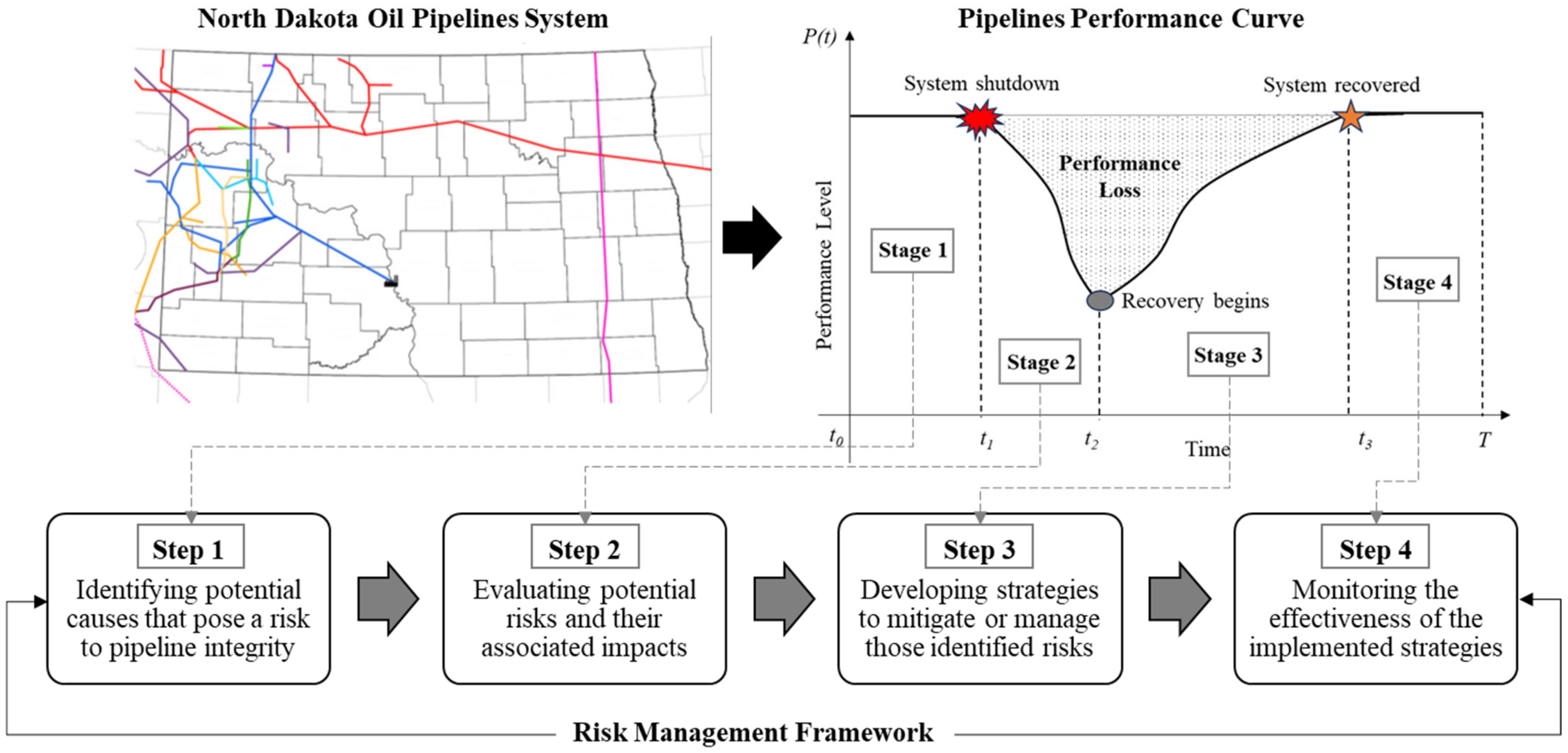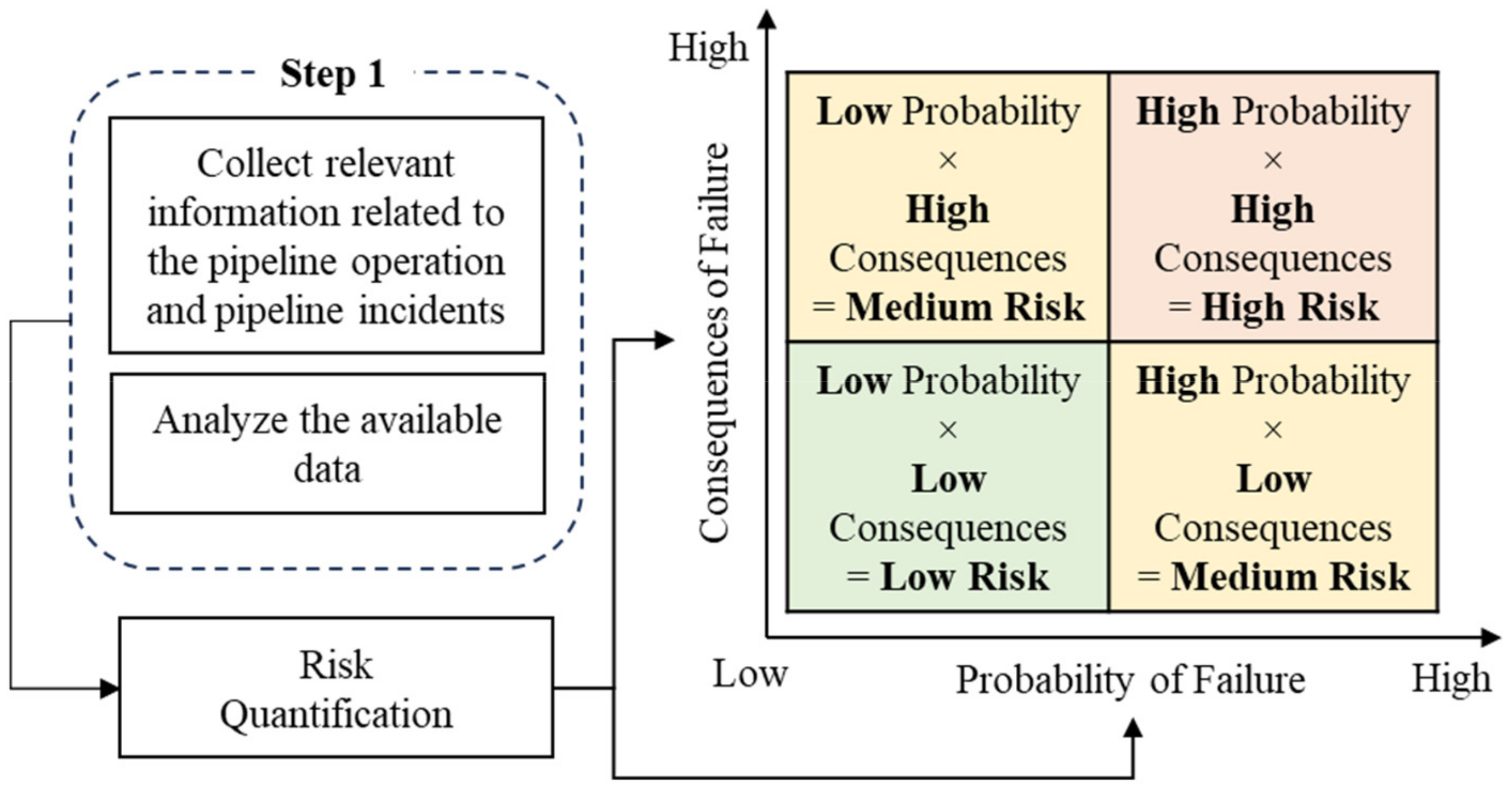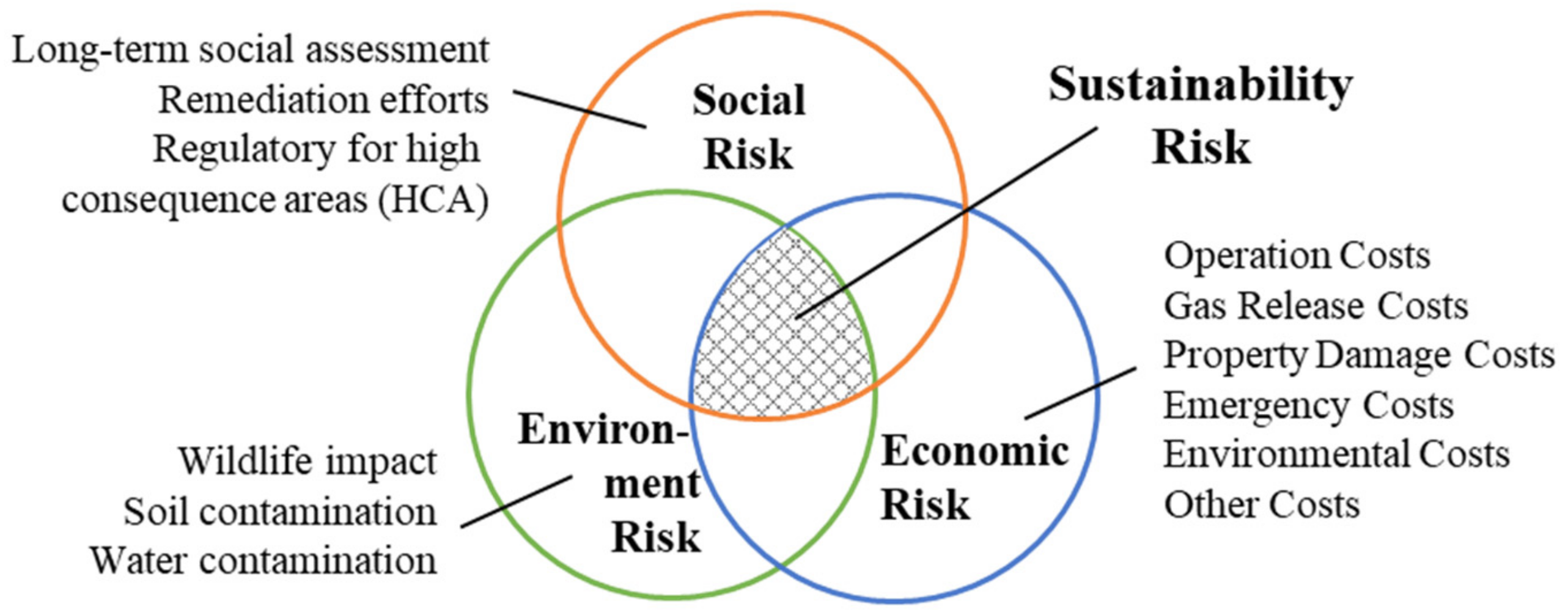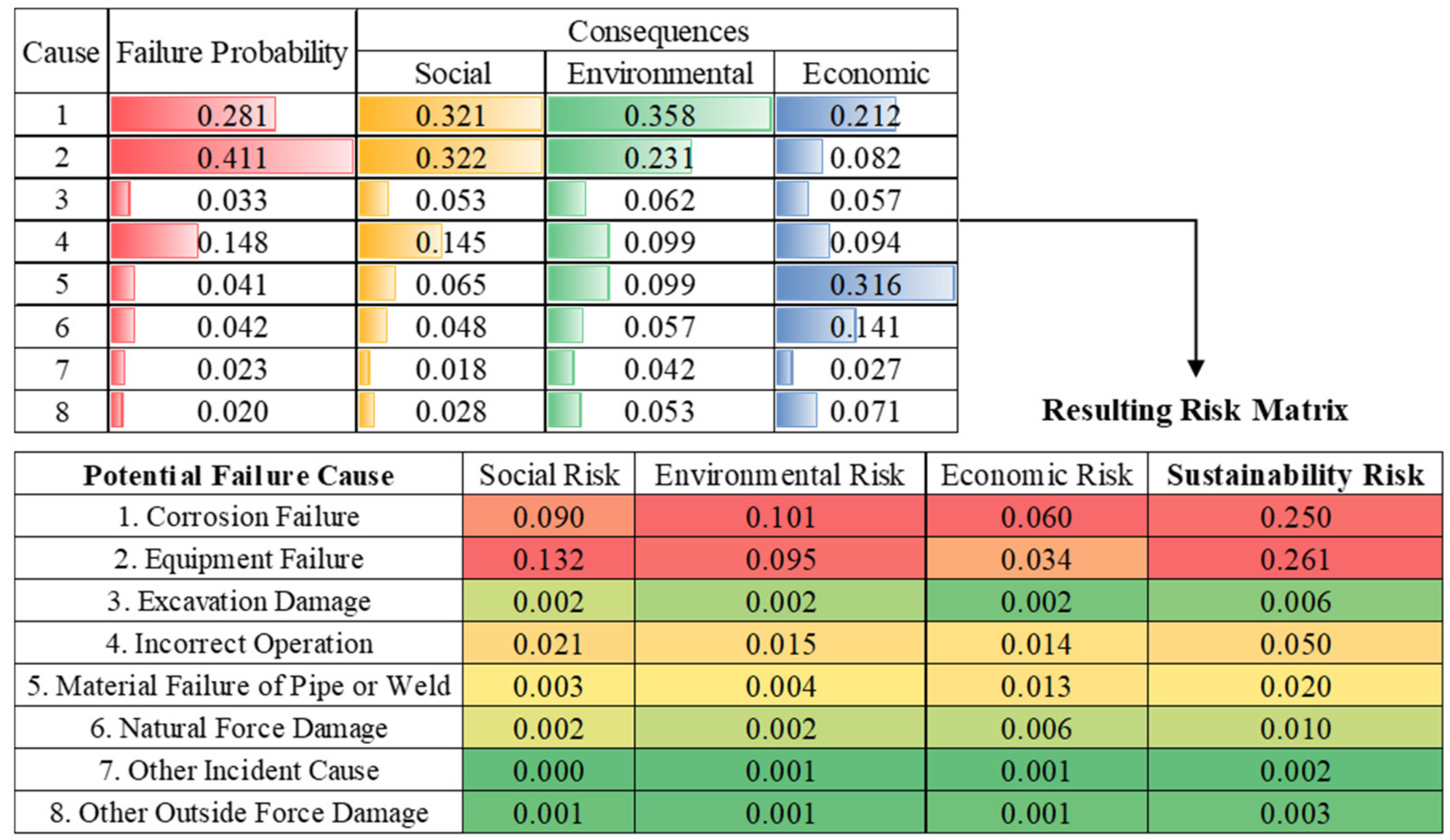A Quantitative Approach of Measuring Sustainability Risk in Pipeline Infrastructure Systems
Abstract
1. Introduction
2. Literature Review
3. Methodology
3.1. Risk Management Framework
3.2. Risk Quantification
3.2.1. Probability of Failure
- If historical failure data for the specific failure event or component failure are available, they can be used to calculate the failure rate [29]. The failure rate is the number of failures divided by the total operating time, which can be expressed as failures per unit of time, for example, failures per month or failures per year.
- If historical data are not sufficient, limited, unavailable, or unreliable, the failure rate can be estimated based on expert opinions [41], industry standards, similar components’ failure rates, or through simulation/experiment of the failure event.
3.2.2. Consequences of Failure
3.3. Sustainability Risk
- Social risks are often associated with community relations, stakeholder engagement, labor practices, human rights, and social equity that could impact the social dimension of sustainability.
- Environmental risks are generally related to natural resource depletion, pollution, habitat destruction, climate change, and other ecological impacts that could threaten environmental sustainability.
- Economic risks are mainly linked to financial stability, economic viability, cost-effectiveness, and resource allocation, which could undermine sustainability’s economic dimension.
4. Data Analysis
4.1. Identifying Potential Failure Causes
- Corrosion failure refers to the degradation of pipeline materials, which can lead to leaks or ruptures, posing significant risks to the integrity of the pipeline system.
- Equipment failure, on the other hand, involves malfunctions in pipeline equipment, presenting operational and safety hazards that demand immediate attention.
- Excavation damage arises when the pipeline is inadvertently hit or punctured during digging or construction work, highlighting the importance of careful excavation practices.
- Incorrect operation incidents result from human error or inadequate maintenance practices, underscoring the need for comprehensive training and adherence to proper procedures.
- Material failure of pipe or weld indicates the presence of defects or weaknesses in the pipeline’s construction, calling for robust quality control measures during installation.
- Natural force damage, occurring from events like earthquakes, landslides, or severe weather, emphasizes the necessity of resilience against unpredictable natural occurrences.
- Outside (or external) force damage involves elements that go beyond the physical structure of the pipeline, encompassing occurrences like vehicle impacts or deliberate third-party actions (vandalism, sabotage, and terrorism) that can cause pipeline damage and subsequent failures.
- Additionally, the dataset reveals other incident causes, which encompass unspecified or external factors contributing to pipeline incidents, underscoring the complexity and multifaceted nature of potential risks.
4.2. Quantifying Failure Probability
4.3. Measuring Probability of the Consequences
5. Results and Discussions
5.1. Sustainability Risk Assessment, Monitoring, and Mitigation
5.2. Discussions
5.3. Research Implications
- In terms of theoretical implications, this study contributes to a deeper theoretical understanding of how sustainability risks can be quantified in the context of pipeline infrastructure systems. It builds upon established sustainability principles and risk management theories. Additionally, the proposed theoretical framework in this study highlights the importance of integrating social, environmental, and economic dimensions when assessing sustainability risk, reflecting a holistic approach to risk management.
- In terms of practical implications, this study provides a quantitative approach for assessing sustainability risk in pipeline operations. Industry practitioners can apply this methodology to enhance the accuracy and effectiveness of risk assessments. By analyzing real-world data, this study identifies specific causes of pipeline incidents, such as corrosion failure and equipment malfunction. This practical insight can guide maintenance and operational decisions. Additionally, the findings from this study can inform the development of practical risk mitigation strategies tailored to the identified sustainability risks, helping organizations proactively manage and reduce disruptions.
- In terms of policy implications, incorporating SDGs into risk management practices, as proposed in the study, has policy implications by aligning risk mitigation efforts with broader societal and global sustainability objectives. Policymakers and regulators can (1) consider the insights from this study when developing or revising regulations related to pipeline infrastructure with a focus on sustainability and risk management, (2) encourage standardized data reporting practices in the industry to enhance transparency and risk evaluation, and (3) promote interdisciplinary collaboration between engineering, sustainability, data analysis, and policy experts to address the complex nature of sustainability risks in pipeline operations.
6. Conclusions
Author Contributions
Funding
Institutional Review Board Statement
Informed Consent Statement
Data Availability Statement
Conflicts of Interest
References
- Chen, C.; Li, C.; Reniers, G.; Yang, F. Safety and security of oil and gas pipeline transportation: A systematic analysis of research trends and future needs using WoS. J. Clean. Prod. 2021, 279, 123583. [Google Scholar] [CrossRef]
- Girgin, S.; Krausmann, E. Historical analysis of U.S. onshore hazardous liquid pipeline accidents triggered by natural hazards. J. Loss Prev. Process Ind. 2016, 40, 578–590. [Google Scholar] [CrossRef]
- Rusin, A.; Stolecka-Antczak, K.; Kapusta, K.; Rogoziński, K.; Rusin, K. Analysis of the Effects of Failure of a Gas Pipeline Caused by a Mechanical Damage. Energies 2021, 14, 7686. [Google Scholar] [CrossRef]
- Paul, L. Oil and Gas Pipeline Cybersecurity. Tex. J. Oil Gas Energy Law 2022, 17, 38. [Google Scholar]
- Afrin, T.; Yadav, O.; Liao, H.; Yodo, N.; Alqarni, A. Artificial Intelligence Condition-based Maintenance towards Oil and Gas Pipeline System Resilience. In Proceedings of the IISE Annual Conference and Expo, New Orleans, LA, USA, 20–23 May 2023; IISE: Peachtree Corners, GA, USA, 2023. [Google Scholar]
- Kraidi, L.; Shah, R.; Matipa, W.; Borthwick, F. An investigation of mitigating the safety and security risks allied with oil and gas pipeline projects. J. Pipeline Sci. Eng. 2021, 1, 349–359. [Google Scholar] [CrossRef]
- Wang, H.; Xu, Y.; Shi, B.; Zhu, C.; Wang, Z. Optimization and intelligent control for operation parameters of multiphase mixture transportation pipeline in oilfield: A case study. J. Pipeline Sci. Eng. 2021, 1, 367–378. [Google Scholar] [CrossRef]
- Berle, Ø.; Norstad, I.; Asbjørnslett, B.E. Optimization, risk assessment and resilience in LNG transportation systems. Supply Chain. Manag. Int. J. 2013, 18, 253–264. [Google Scholar] [CrossRef]
- Khan, F.; Yarveisy, R.; Abbassi, R. Risk-based pipeline integrity management: A road map for the resilient pipelines. J. Pipeline Sci. Eng. 2021, 1, 74–87. [Google Scholar] [CrossRef]
- Mahmood, Y.; Afrin, T.; Huang, Y.; Yodo, N. Sustainable Development for Oil and Gas Infrastructure from Risk, Reliability, and Resilience Perspectives. Sustainability 2023, 15, 4953. [Google Scholar] [CrossRef]
- Jan, A.A.; Lai, F.W.; Asif, M.; Akhtar, S.; Ullah, S. Embedding sustainability into bank strategy: Implications for sustainable development goals reporting. Int. J. Sustain. Dev. World Ecol. 2023, 30, 229–243. [Google Scholar] [CrossRef]
- Jan, A.A.; Lai, F.W.; Siddique, J.; Zahid, M.; Ali, S.E.A. A walk of corporate sustainability towards sustainable development: A bibliometric analysis of literature from 2005 to 2021. Environ. Sci. Pollut. Res. 2023, 30, 36521–36532. [Google Scholar] [CrossRef] [PubMed]
- Aziz, N.A.A.; Manab, N.A.; Othman, S.N. Sustainability risk management (SRM): An extension of enterprise risk management (ERM) concept. Int. J. Manag. Sustain. 2016, 5, 1–10. [Google Scholar] [CrossRef][Green Version]
- Pipeline Basics. Available online: https://primis.phmsa.dot.gov/comm/PipelineBasics.htm (accessed on 17 August 2023).
- Zhu, Y.; Qian, X.M.; Liu, Z.Y.; Huang, P.; Yuan, M.Q. Analysis and assessment of the Qingdao crude oil vapor explosion accident: Lessons learnt. J. Loss Prev. Process Ind. 2015, 33, 289–303. [Google Scholar] [CrossRef]
- Sovacool, B.K. The costs of failure: A preliminary assessment of major energy accidents, 1907–2007. Energy Policy 2008, 36, 1802–1820. [Google Scholar] [CrossRef]
- Biezma, M.V.; Andrés, M.A.; Agudo, D.; Briz, E. Most fatal oil & gas pipeline accidents through history: A lessons learned approach. Eng. Fail. Anal. 2020, 110, 104446. [Google Scholar]
- Ramírez-Camacho, J.G.; Carbone, F.; Pastor, E.; Bubbico, R.; Casal, J. Assessing the consequences of pipeline accidents to support land-use planning. Saf. Sci. 2017, 97, 34–42. [Google Scholar] [CrossRef]
- Restrepo, C.E.; Simonoff, J.S.; Zimmerman, R. Causes, cost consequences, and risk implications of accidents in US hazardous liquid pipeline infrastructure. Int. J. Crit. Infrastruct. Prot. 2009, 2, 38–50. [Google Scholar] [CrossRef]
- Siler-Evans, K.; Hanson, A.; Sunday, C.; Leonard, N.; Tumminello, M. Analysis of pipeline accidents in the United States from 1968 to 2009. Int. J. Crit. Infrastruct. Prot. 2014, 7, 257–269. [Google Scholar] [CrossRef]
- Han, Z.Y.; Weng, W.G. An integrated quantitative risk analysis method for natural gas pipeline network. J. Loss Prev. Process Ind. 2010, 23, 428–436. [Google Scholar] [CrossRef]
- Lawson, K. Pipeline corrosion risk analysis—An assessment of deterministic and probabilistic methods. Anti-Corros. Methods Mater. 2005, 52, 3–10. [Google Scholar] [CrossRef]
- Steenbergen, R.D.; van Gelder, P.H.A.J.M.; Miraglia, S.; Vrouwenvelder, A.C.W.M. (Eds.) Safety, Reliability and Risk Analysis: Beyond the Horizon; CRC Press: Boca Raton, FL, USA, 2013. [Google Scholar]
- Li, X.; Wang, J.; Abbassi, R.; Chen, G. A risk assessment framework considering uncertainty for corrosion-induced natural gas pipeline accidents. J. Loss Prev. Process Ind. 2022, 75, 104718. [Google Scholar] [CrossRef]
- He, S.; Xu, H.; Zhang, J.; Xue, P. Risk assessment of oil and gas pipelines hot work based on AHP-FCE. Petroleum 2023, 9, 94–100. [Google Scholar] [CrossRef]
- Liang, W.; Lin, S.; Liu, M.; Sheng, X.; Pan, Y.; Liu, Y. Risk assessment for cascading failures in regional integrated energy system considering the pipeline dynamics. Energy 2023, 270, 126898. [Google Scholar] [CrossRef]
- Marhavilas, P.K.; Filippidis, M.; Koulinas, G.K.; Koulouriotis, D.E. An expanded HAZOP-study with fuzzy-AHP (XPA-HAZOP technique): Application in a sour crude-oil processing plant. Saf. Sci. 2020, 124, 104590. [Google Scholar] [CrossRef]
- Chakhrit, A.; Chennoufi, M. Failure mode, effects and criticality analysis improvement by using new criticality assessment and prioritization based approach. J. Eng. Des. Technol. 2021. [Google Scholar] [CrossRef]
- Badida, P.; Balasubramaniam, Y.; Jayaprakash, J. Risk evaluation of oil and natural gas pipelines due to natural hazards using fuzzy fault tree analysis. J. Nat. Gas Sci. Eng. 2019, 66, 284–292. [Google Scholar] [CrossRef]
- Shahriar, A.; Sadiq, R.; Tesfamariam, S. Risk analysis for oil & gas pipelines: A sustainability assessment approach using fuzzy based bow-tie analysis. J. Loss Prev. Process Ind. 2012, 25, 505–523. [Google Scholar]
- Yu, Q.; Hou, L.; Li, Y.; Chai, C.; Yang, K.; Liu, J. Pipeline Failure Assessment Based on Fuzzy Bayesian Network and AHP. J. Pipeline Syst. Eng. Pract. 2023, 14, 04022059. [Google Scholar] [CrossRef]
- Burton, I. Report on reports: Our common future: The world commission on environment and development. Environ. Sci. Policy Sustain. Dev. 1987, 29, 25–29. [Google Scholar] [CrossRef]
- Global Initiative Reporting (GRI) Standard. GRI 11: Oil and Gas Sector 2021; GRI Secretariat: Amsterdam, The Netherlands, 2022. [Google Scholar]
- Huang, D.Z. Environmental, social and governance (ESG) activity and firm performance: A review and consolidation. Account. Financ. 2021, 61, 335–360. [Google Scholar] [CrossRef]
- Singh, R. Pipeline Integrity: Management and Risk Evaluation; Gulf Professional Publishing: Cambridge, MA, USA, 2017. [Google Scholar]
- Yodo, N.; Afrin, T.; Yadav, O.P.; Wu, D.; Huang, Y. Condition-based monitoring as a robust strategy towards sustainable and resilient multi-energy infrastructure systems. Sustain. Resilient Infrastruct. 2023, 8 (Suppl. S1), 170–189. [Google Scholar] [CrossRef]
- Abdoul Nasser, A.H.; Ndalila, P.D.; Mawugbe, E.A.; Emmanuel Kouame, M.; Arthur Paterne, M.; Li, Y. Mitigation of risks associated with gas pipeline failure by using quantitative risk management approach: A descriptive study on gas industry. J. Mar. Sci. Eng. 2021, 9, 1098. [Google Scholar] [CrossRef]
- Anderson, D.R. The critical importance of sustainability risk management. Risk Manag. 2006, 53, 66–72. [Google Scholar]
- Jozi, S.A.; Rezaian, S.; Shahi, E. Environmental Risk Assessment of Gas Pipelines by Using of Indexing System Method (Case Study: Transportation Pipelines 12 inches, Aabpar—Zanjan of Iran). In Proceedings of the 2nd International Conference on Chemistry and Chemical Process (ICCCP), Kuala Lumpur, Malaysia, 5–6 May 2012; Elsevier Science: Amsterdam, The Netherlands, 2012. [Google Scholar]
- Lu, L.; Liang, W.; Zhang, L.; Zhang, H.; Lu, Z.; Shan, J. A comprehensive risk evaluation method for natural gas pipelines by combining a risk matrix with a bow-tie model. J. Nat. Gas Sci. Eng. 2015, 25, 124–133. [Google Scholar] [CrossRef]
- Cagno, E.; Caron, F.; Mancini, M.; Ruggeri, F. Using AHP in determining the prior distributions on gas pipeline failures in a robust Bayesian approach. Reliab. Eng. Syst. Saf. 2000, 67, 275–284. [Google Scholar] [CrossRef]
- Mehrafrooz, B.; Edalat, P.; Dyanati, M. Cost consequence-based reliability analysis of bursting and buckling failure modes in subsea pipelines. J. Ocean. Eng. Sci. 2019, 4, 64–76. [Google Scholar] [CrossRef]
- Williams, D. Pipeline Risk Assessment Fundamentals. Available online: https://dynamicrisk.net/wp-content/uploads/2021/04/Risk-Assessment-Tutorial-Presentation_Banff_2021pptx.pdf (accessed on 17 August 2023).
- Afrin, T.; Yodo, N. A Hybrid Recovery Strategy toward Sustainable Infrastructure Systems. J. Infrastruct. Syst. 2022, 28, 04021054. [Google Scholar] [CrossRef]
- Hempel, L.; Kraff, B.D.; Pelzer, R. Dynamic interdependencies: Problematising criticality assessment in the light of cascading effects. Int. J. Disaster Risk Reduct. 2018, 30, 257–268. [Google Scholar] [CrossRef]
- Fingas, M. Introduction to oil spills and their clean-up. In Petrodiesel Fuels; Routledge: Abingdon-on-Thames, UK, 2021; pp. 875–889. [Google Scholar]
- All Reported Incident 20 Year Trend. Available online: https://portal.phmsa.dot.gov/analytics/saw.dll?Portalpages&PortalPath=%2Fshared%2FPDM%20Public%20Website%2F_portal%2FSC%20Incident%20Trend&Page=All%20Reported (accessed on 17 August 2023).
- Awuku, B.; Huang, Y.; Yodo, N. Predicting Natural Gas Pipeline Failures Caused by Natural Forces: An Artificial Intelligence Classification Approach. Appl. Sci. 2023, 13, 4322. [Google Scholar] [CrossRef]
- Basiago, A.D. Economic, social, and environmental sustainability in development theory and urban planning practice. Environmentalist 1998, 19, 145–161. [Google Scholar] [CrossRef]
- Parfomak, P.W. Dot’s Federal Pipeline Safety Program: Background and Key Issues for Congress; Congressional Research Service. 2015. Available online: https://nationalaglawcenter.org (accessed on 17 August 2023).
- Li, X.; Penmetsa, P.; Liu, J.; Hainen, A.; Nambisan, S. Severity of emergency natural gas distribution pipeline incidents: Application of an integrated spatio-temporal approach fused with text mining. J. Loss Prev. Process Ind. 2021, 69, 104383. [Google Scholar] [CrossRef]
- Huang, Y.; Liang, X.; Azarmi, F. Innovative Fiber optic sensors for pipeline corrosion monitoring. In Proceedings of the Conference on Pipelines 2014: From Underground to the Forefront of Innovation and Sustainability, Reston, VA, USA, 4 August 2014; pp. 1502–1511. [Google Scholar]





| Potential Failure Cause | Frequency | Failure Probability, Pfi |
|---|---|---|
| Corrosion Failure | 689 | 0.281 |
| Equipment Failure | 1008 | 0.411 |
| Excavation Damage | 80 | 0.033 |
| Incorrect Operation | 364 | 0.148 |
| Material Failure of Pipe or Weld | 101 | 0.041 |
| Natural Force Damage | 104 | 0.042 |
| Other Incident Cause | 57 | 0.023 |
| Other Outside Force Damage | 49 | 0.020 |
| Potential Failure Cause | Long-Term Assessment | Remediation Incident | Possible HCA | Commodity Reached HCA | Social Consequences |
|---|---|---|---|---|---|
| Corrosion Failure | 0.288 | 0.389 | 0.297 | 0.308 | 0.321 |
| Equipment Failure | 0.235 | 0.300 | 0.379 | 0.374 | 0.322 |
| Excavation Damage | 0.098 | 0.059 | 0.027 | 0.027 | 0.053 |
| Incorrect Operation | 0.144 | 0.119 | 0.159 | 0.156 | 0.145 |
| Material Failure of Pipe or Weld | 0.121 | 0.054 | 0.044 | 0.042 | 0.065 |
| Natural Force Damage | 0.045 | 0.034 | 0.053 | 0.060 | 0.048 |
| Other Incident Cause | 0.015 | 0.024 | 0.020 | 0.014 | 0.018 |
| Other Outside Force Damage | 0.053 | 0.021 | 0.020 | 0.018 | 0.028 |
| Potential Failure Cause | Wildlife Impact Incident | Soil Contamination | Water Contamination | Environmental Consequences |
|---|---|---|---|---|
| Corrosion Failure | 0.375 | 0.321 | 0.379 | 0.358 |
| Equipment Failure | 0.150 | 0.369 | 0.173 | 0.231 |
| Excavation Damage | 0.075 | 0.042 | 0.070 | 0.062 |
| Incorrect Operation | 0.050 | 0.145 | 0.103 | 0.099 |
| Material Failure of Pipe or Weld | 0.175 | 0.046 | 0.075 | 0.099 |
| Natural Force Damage | 0.050 | 0.036 | 0.084 | 0.057 |
| Other Incident Cause | 0.050 | 0.023 | 0.051 | 0.042 |
| Other Outside Force Damage | 0.075 | 0.018 | 0.065 | 0.053 |
| Potential Failure Cause | Operator Paid | Gas Released | Property Damage | Emergency | Environment | Other Cost | Economic Consequences |
|---|---|---|---|---|---|---|---|
| Corrosion Failure | 0.113 | 0.190 | 0.317 | 0.210 | 0.099 | 0.341 | 0.212 |
| Equipment Failure | 0.131 | 0.143 | 0.127 | 0.043 | 0.023 | 0.027 | 0.082 |
| Excavation Damage | 0.008 | 0.142 | 0.092 | 0.040 | 0.029 | 0.031 | 0.057 |
| Incorrect Operation | 0.027 | 0.153 | 0.170 | 0.057 | 0.020 | 0.135 | 0.094 |
| Material Failure of Pipe or Weld | 0.421 | 0.141 | 0.097 | 0.380 | 0.744 | 0.115 | 0.316 |
| Natural Force Damage | 0.106 | 0.148 | 0.108 | 0.169 | 0.016 | 0.300 | 0.141 |
| Other Incident Cause | 0.005 | 0.048 | 0.053 | 0.037 | 0.017 | 0.000 | 0.027 |
| Other Outside Force Damage | 0.188 | 0.036 | 0.036 | 0.064 | 0.051 | 0.051 | 0.071 |
| Potential Failure Cause | Failure Consequences, ωij | ||
|---|---|---|---|
| Corrosion Failure | 0.281 | 0.891 | 0.250 |
| Equipment Failure | 0.411 | 0.635 | 0.261 |
| Excavation Damage | 0.033 | 0.172 | 0.006 |
| Incorrect Operation | 0.148 | 0.338 | 0.050 |
| Material Failure of Pipe or Weld | 0.041 | 0.480 | 0.020 |
| Natural Force Damage | 0.042 | 0.246 | 0.010 |
| Other Incident Cause | 0.023 | 0.087 | 0.002 |
| Other Outside Force Damage | 0.020 | 0.152 | 0.003 |
| Corrosion Failure | Equipment Failure | Incorrect Operation |
|---|---|---|
| Coating and cathodic protection | Condition monitoring | Comprehensive training |
| Regular inspections | Regular maintenance | Standard operating procedures |
| Corrosion monitoring | Spare parts inventory | Checklists |
| Material selection | Operator training | Automation and controls |
| Environmental assessment | Emergency shutdown systems | Feedback mechanisms |
| Advance sensors | Redundancy | Human–machine interface designs |
Disclaimer/Publisher’s Note: The statements, opinions and data contained in all publications are solely those of the individual author(s) and contributor(s) and not of MDPI and/or the editor(s). MDPI and/or the editor(s) disclaim responsibility for any injury to people or property resulting from any ideas, methods, instructions or products referred to in the content. |
© 2023 by the authors. Licensee MDPI, Basel, Switzerland. This article is an open access article distributed under the terms and conditions of the Creative Commons Attribution (CC BY) license (https://creativecommons.org/licenses/by/4.0/).
Share and Cite
Asha, L.N.; Huang, Y.; Yodo, N.; Liao, H. A Quantitative Approach of Measuring Sustainability Risk in Pipeline Infrastructure Systems. Sustainability 2023, 15, 14229. https://doi.org/10.3390/su151914229
Asha LN, Huang Y, Yodo N, Liao H. A Quantitative Approach of Measuring Sustainability Risk in Pipeline Infrastructure Systems. Sustainability. 2023; 15(19):14229. https://doi.org/10.3390/su151914229
Chicago/Turabian StyleAsha, Labiba Noshin, Ying Huang, Nita Yodo, and Haitao Liao. 2023. "A Quantitative Approach of Measuring Sustainability Risk in Pipeline Infrastructure Systems" Sustainability 15, no. 19: 14229. https://doi.org/10.3390/su151914229
APA StyleAsha, L. N., Huang, Y., Yodo, N., & Liao, H. (2023). A Quantitative Approach of Measuring Sustainability Risk in Pipeline Infrastructure Systems. Sustainability, 15(19), 14229. https://doi.org/10.3390/su151914229






